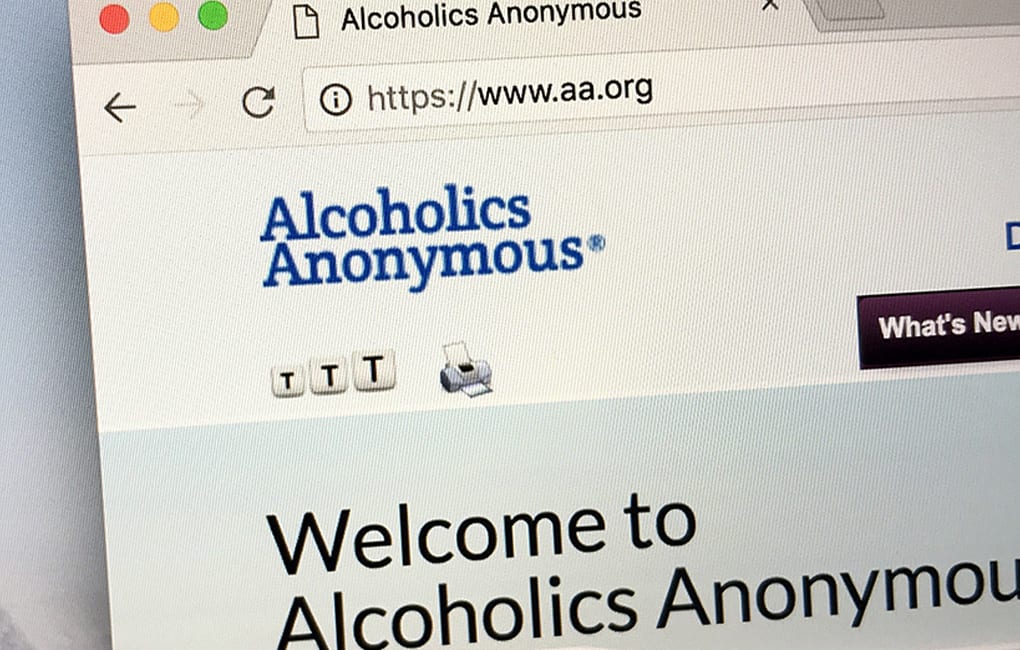Skip Ahead to Topic
What is Alcoholics Anonymous?
Alcoholics Anonymous (AA) is a fellowship organization for people struggling with alcoholism. It is the largest alcohol support organization in the world, with a membership of over two million as of 2018. AA members include individuals from diverse socioeconomic backgrounds, cultures, values and beliefs. What every member shares in common is the desire to get – and stay – sober.
The keystone of AA is its Twelve Steps program, a set of guidelines for recovering from addiction to alcohol and other controlling substances or behaviors. The AA Twelve Steps have become the foundation for dozens of other recovery groups and have helped many people find freedom from life-controlling addictions.
The History of AA
The spark that started Alcoholics Anonymous was struck in Akron, OH in 1935. There, two recovering alcoholics, Bill Wilson and Bob Smith, had a conversation about the nature of alcoholism and how to overcome it.
Wilson, a New York stockbroker, had only recently gotten sober through the help of an outreach program called the Oxford Group, which emphasized surrender of one’s life to God as the key to right living. Work brought Bill to Akron in 1935, where he was again tempted to drink. Having discovered through his experience with the Oxford Group that fellowship with others in recovery was critical to staying sober, he reached out to a local church for help and was connected to another Oxford Group alcoholic, Dr. Bob Smith. The two men formed an immediate bond, and just a few months later, Bob, too, quit drinking for good. That summer, Bill and Dr. Bob began working together to help other alcoholics, at first meeting with them one at a time in a room in Bob’s home.
It took four years for Bill and Dr. Bob to guide 100 people to sobriety through three recovery fellowships formed during that time. Then the penning of the fellowship’s textbook, Alcoholics Anonymous, in 1939, catapulted the new organization into the limelight and resulted in an explosion of growth. This book contained the group’s philosophy for recovery from alcoholism, along with its methods, the Twelve Steps, and the personal redemption stories of a number of its members. The fellowship adopted the name of the book’s title. Thanks to some positive publicity, Alcoholics Anonymous attracted national attention and its membership took off. By the end of 1941, AA membership had jumped to 6,000. With the multiplication of members and groups, the founders found themselves dealing more often with disputes within AA groups regarding religion, publicity, and finances. Dealing with these internal disputes inspired Bill to formulate the Twelve Traditions, a set of guidelines for the operation of AA groups meant to promote their unity and preserve their purpose. The Twelve Traditions were first presented in a revised publication of AA’s textbook, in the first edition of a book now popularly known as AA’s “Big Book.”
By 1950, the numbers had skyrocketed to 100,000 worldwide members, and AA’s first international convention was held. Alcoholics Anonymous has grown steadily since, penetrating barriers of race, creed and ideology few such programs have. The Twelve Steps and Twelve Traditions remain as the foundation of AA, their content neatly summarized in this quotation from the Big Book: “Trust God, clean house, help others.”

The Twelve Steps
Today it’s close to impossible to be an alcoholic or drug addict in recovery and not be familiar with the 12 Steps of AA. These steps, which outline how to overcome life controlling addictions and make life manageable again, are ubiquitous. And with good reason. These steps have helped hundreds of thousands regain control of their lives and repair their relationships. The Steps are as follows:
-
We admitted we were powerless over alcohol—that our lives had become unmanageable.
-
Came to believe that a Power greater than ourselves could restore us to sanity.
-
Made a decision to turn our will and our lives over to the care of God as we understood Him.
-
Made a searching and fearless moral inventory of ourselves.
-
Admitted to God, to ourselves, and to another human being the exact nature of our wrongs.
-
Were entirely ready to have God remove all these defects of character.
-
Humbly asked Him to remove our shortcomings.
-
Made a list of all persons we had harmed and became willing to make amends to them all.
-
Made direct amends to such people wherever possible, except when to do so would injure them or others.
-
Continued to take personal inventory and when we were wrong promptly admitted it.
-
Sought through prayer and meditation to improve our conscious contact with God as we understood Him, praying only for knowledge of His will for us and the power to carry that out.
-
Having had a spiritual awakening as the result of these steps, we tried to carry this message to alcoholics, and to practice these principles in all our affairs.

Step 1 requires that alcoholics seeking freedom admit they cannot control their drinking and that it has had a catastrophic impact upon their lives.
Steps 2 and 3 shift attention away from the helplessness and hopelessness of the alcoholic to the rescue that can come from a “Higher Power,” if the individual is willing to get out of his or her own way and surrender control.
Step 4 tackles the leviathan of denial that makes addiction recovery so difficult. Alcoholism is a selfish, destructive disease, and it’s critical that alcoholics who wish to recover honestly examine themselves and their past choices in order to understand what they have to work with in themselves and what needs to change.
The confession that takes place in Step 5 paves the way for self-forgiveness and surrender of the behaviors and attitudes that hold the alcoholic back from fully recovery (Steps 6 and 7).
The 8th and 9th Steps are about “cleaning up one’s mess”: tending to the social wreckage wrought by the addiction. Continue to carry the guilt of guilt for past wrongs is a huge impediment to recovery.
Step 10 helps alcoholics to see that they are undertaking a lifestyle change; these practices of self-evaluation and admitting wrongs must be ongoing.
The 11th Step reminds the alcoholic that the wisdom and the ability to maintain this new lifestyle comes through that Higher Power that jumpstarted the whole process.
Finally, Step 12 drives home the reality that recovery form alcoholism requires removing oneself from the center of one’s existence. In helping others, specifically other alcoholics, those in recovery are given a sense of purpose and reminded of where they’ve come from (and no longer wish to be!)

Alcoholics Anonymous Meetings
AA meetings are locally organized and locally run. It’s possible to find an AA meeting happening in nearly every city and town in the U.S. on any given day. There is the option to participate in AA meetings online as well.
Want to attend an AA meeting in Austin?
There are AA meetings specifically for teens, women, atheists and agnostics, the hearing impaired, Spanish speakers and other groups in the Austin area. The Hill Country Intergroup AA website features listings of daily and upcoming meetings near you. See the Oficina Intergrupal Hispana A.A. for assistance in Spanish.
Types of Meetings
When exploring your options for AA meetings, you will notice there are different meeting types. The two main meeting types are open meetings, which are open to both alcoholics and their guests (family members, for example), and closed meetings, which are restricted to alcoholics only.
Online meeting descriptions may also contain additional information to help you understand the format of the meeting. There are speaker meetings, where one or more chosen speakers will share at length about their addiction and recovery experiences. At discussion meetings, a chairperson usually selects a topic for conversation, and group members who wish to contribute share on that topic. Big Book meetings, as you might expect, involve reading and discussion from AA’s Big Book. Another text-based meeting is the Step meeting, where a group focuses on studying one or several of the Twelve Steps. A meditation meeting allots a certain amount of time for group members to quiet themselves through meditation before proceeding to discussion or some other activity.
What to Expect at an AA Meeting
The exact format varies from meeting to meeting, but many AA meetings commence with a cup of coffee, after which the leader will call the meeting to order. At this point, members may recite a prayer or some other affirmation. Then the group leader, or chairperson, welcomes everyone, including any new members. New members may be congratulated on finally deciding to do away with their destructive habits.
Members who have maintained their sobriety are given tokens to mark the length of their sobriety at meetings. These tokens serve as reminders for alcoholics to take recovery a day at a time and encourages them to celebrate every small victory on the road to wellness. At a discussion meeting, members might then be invited to share their stories.
It’s normal to feel apprehensive about your first meeting, for various reasons, but AA meetings are very welcoming. For starters, there are no special requirements to attend most meetings apart from a desire to get sober. You can show up wherever you are in the recovery process and be received without judgment.
Beginners are encouraged to introduce themselves and to participate but are not pressured to do so. Groups are accustomed to newcomers who want to sit and just observe for their first couple – or several dozen – meetings and are generally respectful of members’ comfort levels and preferences. You can choose to open up about your struggles or not. Either way, you’ll be welcome.
Once they’ve adjusted to the meeting format and people, most AA members find great comfort in being able to talk openly to others who can understand their struggles. Hearing others honestly admit their mistakes and try to make sense of them can help lift the cloud of shame hanging over many alcoholics, freeing them to take that risk to process their own pain with the group. It’s incredibly freeing and comforting to find you are not alone, and that others accept you, failings and all.
Don’t be discouraged if it takes some time for you to get comfortable. Participating in a recovery support group can be a frighteningly vulnerable experience for some people. If that’s you, exercise self-compassion and takes things one step at a time. You may want to try several different meetings and choose which fits best for you. Keep showing up and eventually you will settle in and be able to access AA’s tools and support to take your recovery to the next level.
To learn more about AA groups and how they function, AA’s informative brochure, “The AA Group…where it all begins” is helpful reading.
The Benefits of Alcoholics Anonymous
One of the biggest benefits of Alcoholics Anonymous meetings is captured in the expression “There is strength in numbers.” Everyone at an AA meeting is seeking the same goal: recovery from alcoholism, or some other addiction. In this environment of shared struggle and hope, there is little judgment and lots of compassion and practical help. A few reasons to give AA a shot include:
Support
Every sober addict or alcoholic knows how brutal the recovery process can be. There are terrible physiological cravings that can drive someone to relapse, along with challenging life circumstances, health issues, and social temptations. Hearing success stories at meetings, working the Steps, and talking over tough stuff with a sponsor have helped many alcoholics the strength to keep moving forward.
Furthermore, for alcholics who do not have support from their families, an AA group can become that network of people that care for you, watch out for you, and give you tough love when you need it.
Then there’s the part where you, once you begin to rediscover your strength, get to give to others in recovery who need it. Joy and a sense of purpose in serving others can become a more powerful “high” than alcohol or drugs ever were.
Education
AA literature is very instructive when it comes to the nature of addiction. AA members learn a lot about the beast they’re fighting, as well as themselves, as they work through the 12 Steps.
AA meetings also help people by exposing them to reocvery “hacks”. These hacks focus on what works and what doesn’t when it comes to sober living. Group members share coping strategies that have enabled them to stay sober, which may also work for you. Also, interacting with AA members who have relapsed but fought their way back provides a stark reminder of just how bad substance abuse can be and why it is essential to remain sober.
Free Help
Treatment centers, doctors, therapists, and other recovery resources can be expensive, especially for the un-or under-insured. AA in Austin won’t cost you a thing. Don’t make the mistake of valuing AA according to its price-point, though. In this case, “free” doesn’t equal “cheap.”
Does AA Work?
Formal research into the effectiveness of AA has yielded mixed results, largely because of the difficulty of proving causation, questions about the quality of the evidence (AA members do value their anonymity, after all), and differing definitions of what “success” looks like. A quick Google search on the subject of AA’s success rates will lead you to a multitude of studies and statistics, if you’re someone who has to “read the reviews”, so speak, before “buying” into the need for a recovery group.
But recovery support is not your next Amazon purchase. At its simplest, AA is a set of truths and a gathering of people.
Test the principles by trying them out yourself, and the value of recovery support by experiencing it, and make your own results.
As with so many other things in life, AA will be what you make of it.


Recent Comments